Papers
My profiles in ORCID, SSRN, RePEc and Google Scholar. My thesis—consists of extended versions of "Fraternities and Labor Market Outcomes", "University Competition, Grading Standards and Grade Inflation", and "Equilibrium Sovereign Default with Endogenous Exchange Rate Depreciation".
Published, Forthcoming and Accepted
Tactical Refereeing and Signaling by Publishing. Forthcoming in Kyklos.
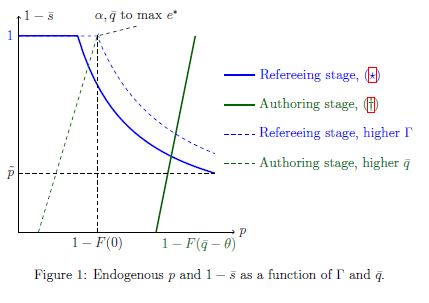
Peer review is usually conducted to allocate limited resources, such as the budget of a funder or the pages of a journal. Limited capacity may bias peer evaluations, precisely because approving a peer's worthy project consumes capacity, jeopardising the referee's own project's chances. I show that limiting capacity is inconsistent with a hypothesis that the decision-maker desires to stimulate efforts. I show that the desire to strengthen the signaling message of the acceptance decision could lead to limiting the capacity, endogenously creating a tragedy of informational commons problem.
Same Sex Marriage, The Great Equalizer, with Aleksey Parakhonyak. Mathematical Social Sciences, December 2025.
In a search and matching model with Nash bargaining, we find infinitely many asymmetric equilibria in which one sex receives a lower payoff than a similarly productive agent of the opposite sex. The mechanism resembles a social norm: if all agents on the opposite side of the marriage market become more demanding, continued searching yields diminished returns. However, if same-sex marriage is legalized and each side of the market includes a positive, arbitrarily small, share of bisexual agents, then only symmetric equilibria survive. This result highlights how restrictions on same-sex marriage reinforce asymmetries in opposite-sex matchings.
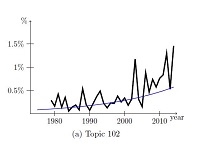
Leadership in Scholarship: Editors' Appointments and Scientific Narrative, with Ali Sina Önder and Sascha Schweitzer. Scottish Journal of Political Economy, July 2025. AER topic loadings in time, words in topics, visualization.
Academic journals disseminate new knowledge, and editors of prominent journals are in a position to affect the direction and composition of research. Using machine learning procedures, we measure the influence of editors of the American Economic Review (AER) on the relative topic structure of papers published in the AER and other top general interest journals. We apply the topic analysis apparatus to the corpus of all publications in the Top 5 journals in Economics between 1976 and 2013, and also to the publications of the AER's editors during the same period. This enables us to observe the changes occurring over time in the relative frequency of topics covered by the AER and other leading general interest journals over time. We .nd that the assignment of a new editor tends to coincide with a change of topics in the AER in favour of a new editor's topics which can not be explained away by shifts in overall research trends that may be observed in other leading general interest journals. Presented at:
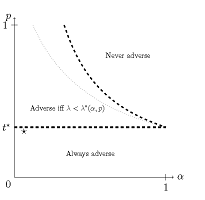
Arithmetics of Research Specialization. Bulletin of Economic Research, November 2023.
In hiring decisions, universities explicitly reward focusing on a specific field. I model the use of research specialization (focusing) in hiring as a signal of ability. Without explicit reward for focusing, candidates who focus are more likely to be able. However, if job market rewards focusing, less able candidates who would otherwise be indifferent between focusing or not, start focusing, which leads to smaller likelihood of observing an able candidate among those who focus than among those who don't. Specialization works as an effective ability signal only when generation of good ideas is highly likely for all ability levels.
Alma Mat(t)er(s): Determinants of Early Career Success in Economics, with Sascha Baghestanian who had to withdraw authorship due to restrictions of his current employer. PLOS One, November 2022.
We study 6000 author-publication observations to investigate predictors of early career success in six fields of Economics. Concentrating on top researchers enables us to control for the effects of ability and effort, and focusing on the start of their careers minimizes distortions from reputation feedback. Our results reveal that the most important predictor for early career success is the ranking of an author’s PhD granting institution, followed by his first placement. Our insights suggest that a counterfactual decrease in the Alma Mater of a high ability author, who graduated from a top 10 university, by as little as 10 to 20 ranks, reduces his probability of getting a top 5 publication significantly by 13 percentage points. Lowering the ranking of his Alma mater by another 80 ranks decreases his chances of getting a top publication by a factor of three. Our findings suggest that the Economics publication market values Alma mater signals, discounting newcomers graduating from- or working at lower ranked departments.

On Publication, Refereeing and Working Hard. With Sascha Baghestanian. Canadian Journal of Economics, November 2018.
We present a model for academia with heterogeneous author types and endogenous effort to explain the changes in the publication process in Economics as a result of changes in institutional parameters. We analyze the implications of these developments on research output quantity and quality. We obtain predictions about the implementation of a few suggestions from the literature regarding the organization of the publication market, and we outline the likely informational content of publication decisions.
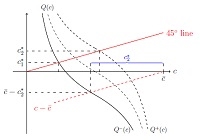
Optimal Product Placement, with Chia-Ling Hsu, Rafael da Matta and Takeharu Sogo. Review of Industrial Organization, August 2017. Code for Example 2.
We propose a model of software market which uses an intermediary to distribute products from sellers to buyers. When products of sellers are vertically differentiated, an intermediary, earning a proportion of sales, has an incentive to hide all but two sellers on the second page, and only keep the best- and the worst-quality sellers on the first page: that weakens the competition, allowing the seller with the best product to charge higher price. Worst product seller has to charge the price of zero. Heterogeneous search costs have nontrivial implications for the platform choice.
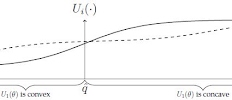
Tenure-Track Contract Helps Self-Selection. Economics Bulletin, November 2015.
Tenure-track contract is criticized for curbing the incentives for spending effort after obtaining the tenured status. Yet, the most productive faculty seems to work on a tenure contract, and schools who aim to employ the best faculty seem to prefer to offer tenure-track contracts to their new hires. I argue that tenure-track contracts are by construction more attractive to more able freshly minted PhDs, and therefore the observed sorting is rationalizable.
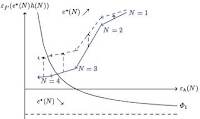
Teamwork Efficiency and Company Size. With Mikhail Galashin, BE Journal of Theoretical Economics, January 2016.
We study how ownership structure and management objectives interact in determining the company size without assuming informational shortcomings or explicit costs of management. For a general class of payoff functions, we characterize the optimal company size. To accomplish that, we show how the general effort aggregation function can be boiled down to the teamwork efficiency function. The shape of the teamwork efficiency function turns to be the key determinant of the optimal effort choice under various institutional settings, which in turn provides insights for the optimal size of the firm. We demonstrate the restrictiveness of the common assumptions on effort aggregation (i.e., constant elasticity of effort substitution), and we show that common intuition (i.e., that corporate companies are more efficient and therefore will be larger in size than equal-share partnerships) might not hold in general.
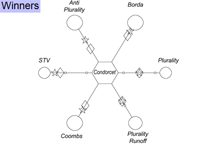
Consensus in organizations: Hunting for the social choice conundrum in APA elections. With Anna Popova and Michel Regenwetter. Presentation, poster, software. Decision, April 2014.
Managers of business, political, governmental, and nongovernmental organizations frequently face the question: "Which of several choice options best represents the consensual preference among members of our organization?" The mathematical theory of preference aggregation, "social choice theory" is commonly interpreted to predict that rational consensus formation is hopeless. Rational social choice appears to be doomed by voting paradoxes and mathematical impossibilities. Behavioral social choice tackles the empirical question of consensus formation in real organizations and electorates. We investigate the performance of seven major social choice procedures on twelve extraordinarily large-scale and rich ballot data sets from a prominent and diverse organization, the American Psychological Association. The analysis provides little support for the pessimistic predictions of rational social choice theory. On the contrary, competing consensus methods agree almost perfectly on the overall best and worst options. The agreement is robust under perturbations of the preference profile via resampling, even in relatively small samples from the data sets. Rational consensus among members of the American Psychological Association, despite the diversity of its membership, appears to be very much possible. In contrast to other areas of behavioral economics, this is a case where human performance vastly exceeds rational expectations. Future research should study organizational cultures, as well as management tools and practices, that explain, facilitate and/or enhance the possibility of rational consensus formation.
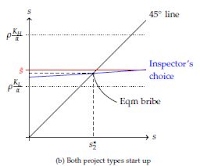 Decentralized Bribery and Market Participation. Presentation. Scandinavian Journal of Economics, January 2015.
Decentralized Bribery and Market Participation. Presentation. Scandinavian Journal of Economics, January 2015.
I propose a bribery model that examines decentralized bureaucratic decisionmaking. There are multiple stable equilibria. High levels of bribery reduce an economy's productivity because corruption suppresses small business, and reduces the total graft even though individual bribe size might increase. Decentralization prevents movement towards a Pareto-dominant equilibrium. Anti-corruption efforts, even temporary ones, might be useful to improve participation if they lower demanded bribe levels and thus encourage small businesses to participate.
University Competition, Grading Standards and Grade Inflation. With Dan Bernhardt. Presentation, poster, Economic Inquiry, July 2013.
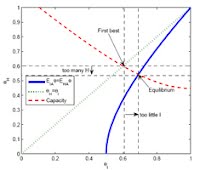
Some universities have more students with high GPAs than others, and claim that it is because they have better students. We show how strategic considerations lead better universities to set lower standards for good grades. In our model, universities are distinguished by the distribution of student academic abilities. Job placement and wages hinge on a firm's assessment of a student's productivity given the student's university, grade and productivity signal. Universities choose grading standards to maximize the total wage bill of their graduates. We identify conditions under which better universities endogenously set lower grading standards, exploiting the fact that firms cannot distinguish between "good A's" and "bad A's". In sharp contrast, a social planner sets stricter grading standards at better universities. Finally, we show that an increase in skilled jobs drives grade inflation, and identify conditions under which grading standards fall faster at better schools.
In Pursuit for Impeccable Veracity. I study the institution of avoiding to hire one's school own PhD graduates for assistant professorships. I argue that this institution is necessary to create better incentives for researchers to incorporate new information in studies, facilitating the convergence to asymptotic learning of the studied fundamentals. Economics Letters, March 2012.
Fraternities and Labor Market Outcomes. With Dan Bernhardt. Presentation, poster, data and estimation programs. American Economic Journal: Microeconomics, February 2012.
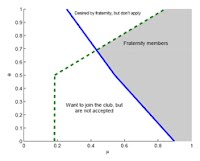
We model how the choices by students to "rush" a fraternity, and the choices by a fraternity of whom to admit, interact with the signals that firms receive about student productivities to determine labor market outcomes. Both the fraternity and students care about future wages and fraternity socializing values. We first show that if the signals firms receive about students are either perfectly informative or perfectly noisy, then fraternity membership has no impact on labor market outcomes. For intermediate signaling technologies, however, three types of equilibria can exist: pessimistic beliefs by firms about the abilities of fraternity members can support an equilibrium in which no one pledges; optimistic beliefs can lead to higher wages for fraternity members than non-members, so that in equilibrium everyone whom the fraternity would like to admit actually pledges; and an equilibrium in which most fraternity members have intermediate abilities - less able students apply, hoping to be mixed in with better students, but are rejected unless they have high fraternity socializing values, while most very able students do not apply to avoid being tainted in labor market outcomes due to being mixed in with less able fraternity members. We take the model to the data and show that this latter equilibrium can reconcile the ability distribution of fraternity members at the University of Illinois.
Seasonality Analysis of Budget Expenses Related to Regional Budget Balancing. With Aleksei Makrushin and Tatiana Kuzmenko. Applied Econometrics (in Russian), 2006. In the paper we suggest to adjust transfers seasonally. We find that regional budget's expenses are driven by income shocks, and that December expenses are affected by accumulated deficit (or proficit).
Revise & Resubmits, Under Revision and Working Papers
New Immigrants Affect Fellow Existing Immigrants, Not Natives
Full text. With Sara Lemos.
No empirical evidence has ever been reported that the large inflow of accession immigrants – following the 2004 expansion of the European Union – led to a fall in wages or employment, or a rise in unemployment in the UK between 2004 and 2006. Given its unprecedented scale and pace – one of the largest UK immigration inflows on record – the lack of evidence of adverse effects is striking. This immigration shock was unexpectedly larger and faster – as well as more concentrated into areas and occupations – than anticipated, seemingly more akin to an exogenous supply shock than most immigration shocks. This means that there was less scope for anticipated labour market adjustments in the lead up to May 2004: adjustments which might have lessened any adverse impact of the shock. The initial heated debate about the striking lack of evidence of adverse effects gradually turned into a tenuous consensus that this large and fast shock was absorbed without substantial adverse effects on wages or employment. Exploiting rich but underused data from the Lifetime Labour Market Database (LLMDB) we estimate the effect of this immigration shock on wages, employment and unemployment of natives and previously existing immigrants in the UK. We confirm once again the finding of little evidence that the inflow of accession immigrants led to a fall in wages, a fall in employment, or a rise in unemployment of natives in the UK between 2004 and 2006. However, we uncover, for the first time, novel evidence of adverse employment and unemployment effects for low paid existing immigrants as a result of the accession immigration inflow. This is more severe for low paid immigrants and young low paid immigrants as well as for long term unemployed immigrants.
Unrewarded Cooperation

Full text. With Arkady Konovalov and Daniil Luzyanin.
Experiment participants in a social dilemma game choose to cooperate over defecting, even if neither is more individually beneficial. High levels of cooperation cannot be explained by favorable labels for actions, collusion, k-level reasoning, quantal response behavior, or misplaced optimism about others’ actions, but can be rationalized by the Charness and Rabin (2002) preference model. However, cooperation rates fall with changes in payoffs, which cannot be explained by the standard formulation; to account for these results, we introduce a generalization of the model. Presented at:
- ECARES, Solvay Brussels School of Economics and Business, 2025, Belgium.
- University of Illinois. Urbana-Champaign, 2025, USA.
- University of Indiana, Bloomington, 2025, USA.
- University of Sydney, 2024, Australia.
- Monash University, 2024, Australia.
- Cardiff University, 2024, Wales.
- University of Birmingham, 2024, England.
Shirking papers
Equilibrium Sovereign Default with Endogenous Exchange Rate Depreciation
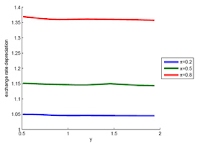
With David Wiczer. Full text, presentation, data and estimation programs, currently under very slow rewriting.
Sovereign default is often associated with major disturbances in a country's trade relations. With some regularity, the defaulter's currency depreciates and the volume of trade falls drastically. This paper develops a quantitative model to incorporate real depreciation along with the sovereign bankruptcy. The exchange rate is endogenously determined as an equilibrium price of imported goods in units of home country production. Our simulations demonstrate that a default episode can imply up to 30% real depreciation, depending upon parameterization and the scale of international exposure. This result is similar to depreciations in developing country crises. It suggests that much of the exchange rate movement can be explained as a market-clearing price adjustment in response to a real change in trade. Presented at:
- Society of Economic Dynamics Annual Meeting, 2010, Montreal, Canada.
- Midwest Macroeconomics Meetings, 2010, East Lansing, MI.
- Midwest Economics Association Meeting, 2010, Chicago, IL.
- Kazakhstan Institute of Management, Economics, and Strategic Research, 2010, Almaty, Kazakhstan.
- Novosibirsk State University, 2009, Novosibirsk, Russia.
- New Economic School, 2009, Moscow, Russia.
- Fourth Annual Graduate Students Conference, 2009, Washington University, St. Louis, MO.
- Illinois Economics Association Meeting, 2009, Chicago, IL; Best Paper prize.
- Missouri Economics Conference, 2009, Columbia, MO.
Learning to Love Money
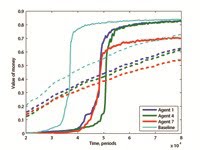
With Tingwen Liu and Dennis O'Dea. Currently given up on.
We study the persistence of money emergence in the learning framework based on Kiyotaki and Wright (1989). We find that the equilibrium with money is the only long-run equilibrium, even when both barter and money equilibria are locally stable, when benefits from trade are big enough. We find that refraining from using money might be suboptimal in the long-run, and that it might be optimal to accept money even in barter equilibrium, to promote universal acceptance. Presented at:
- Chicago FRB's Summer Workshop on Money, Banking, Payments and Finance, 2011, Chicago, IL (Dennis).
- Midwest Macroeconomics Conference, 2011, Nashville, TN.
- Fifth Annual Graduate Students Conference, 2010, Washington University, St. Louis, MO (Tingwen).
- Midwest Economic Theory Conference, 2010, Madison, WI.
- Missouri Economics Conference, 2010, Columbia, MO.
The Scholarly Benefits of Physical Fitness
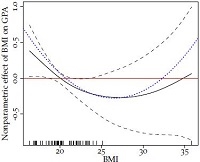
With John V.C. Nye. Full text, currently given up on.
We find that Body Mass Index (BMI) influences the Grade Point Average (GPA) of students at the Higher School of Economics in Nizhny Novgorod. But BMI only matters for students who moved from out of town, ruling out the possibility of professor bias. Lower BMI improves GPA, which rules out malnutrition as an explanation. The difference is probably due to lack of a social network around non-local students, because low-BMI students find new friends faster, which helps the students do better. In contrast, neither low BMI nor having more friends has a positive effect for students who come from Nizhny Novgorod.
Presented at:
- III International Conference of the Russian Association of Higher Education Researchers, Moscow, 2013, Russia.
On Basu's Proposal: Fines Affect Bribes
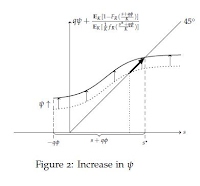
Full text. This paper took too long staying under consideration in various journal, and another researcher has a too similar paper. I retire this paper, and am not pursuing its publication anymore.
I provide a model that connects the bribe amount with the fines imposed on both bribe-taker and bribe-payer. I show that Basu (2011) proposal to not punish bribe-payers to induce whistleblowing does not have to help lower bribes. Higher fines on bribe-takers will make them ask for larger bribes, whereas lowering fines for bribe-paying on bribe-payers might increase their willingness to pay the bribe. An increase in transparency, if achieved, effectively increases both fines simultaneously.
- European Economic Association meeting, 2016, Geneva, Switzerland.